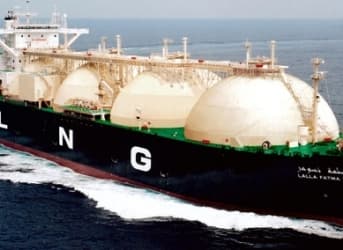The glut in oil is expected to continue for the next year or so before balancing in late 2016, but the pain for liquefied natural gas (LNG) could be just beginning.
Building LNG export terminals is a long-term proposition. It can take years to develop a greenfield project, bringing a lump of new capacity online long after the project was initially planned, exposing developers to the possibility that market conditions could change in the interim. It is not unlike a conventional oil project, such as an offshore well, which also can take years (as opposed to a much shorter lead time for shale drilling).
But there is a major difference between oil and LNG: the market for LNG is much smaller and less liquid (no pun intended). In other words, a handful of new LNG export terminals can significantly alter the supply/demand balance. Related: How Electricity Markets Could be Upended by this Supreme Court Decision
That is exactly what is currently unfolding. Several years ago, spot prices in Asia for LNG spiked, particularly following Fukushima nuclear meltdown. Japan’s demand for LNG skyrocketed. At the same time, the shale gas revolution was unfolding in the U.S., and rock bottom prices opened up a window of opportunity to ship American gas to Asia. But it wasn’t just the U.S. – LNG export terminals proliferated around the world, particularly in Australia.
There were so many projects planned at the same time, and the first batch started to come online this year, with many more nearing completion in 2016 and 2017.
The rush of new supply is hitting the market all at the same time. Not only would such a rush in supply have pushed down prices on their own, the timing is actually really unfortunate for LNG exporters. Economies in East Asia are slowing, leaving a shortfall in demand. Japan, the largest LNG importer, is seeing its economy stagnate. China’s growth has slowed significantly.
Related: 2016 Spells More Gloom For Oil Producers
As a result, JKM spot prices – the LNG marker for East Asia – are trading at $7.28 per million Btu (MMBtu) for December delivery, down nearly two-thirds from early 2014 prices.
Many LNG exporters have their cargoes signed up under long-term contracts on fixed prices. But usually not all of a given supplier’s capacity has secured buyers. The leftovers are sold on the spot market. With prices so low, spot sales are garnering much lower revenue.
Next year may be worse than this year, and 2017 could be yet even worse. "From having been an import basin, Asia will next year be going to have excess supplies and worse so in 2017," David Hewitt of Credit Suisse told Reuters.
New export terminals will add 14 to 15 million tonnes of annual LNG capacity (mtpa) to the spot market over the next year. But that extra supply is running into a wall of stagnating demand. Japan’s LNG imports dropped by 12.8 percent in November, year-on-year. South Korea’s level of imports are at their lowest levels in six years. Related: Tick Tock: Time Running Out for Struggling Oil and Gas Drillers
Credit Suisse’s David Hewitt says that spot prices could drop to $5/MMBtu over the next few months, and even dip to an “eye-watering low” of $4/MMBtu at some point in 2016.
Again, oil markets are expected to see the supply overhang come into balance on a much shorter time horizon, perhaps by late 2016 or 2017. But the LNG market, with a much smaller demand base around the world, has much bigger problems. New regasification terminals will add new demand for LNG over the next few years, and demand is expected to jump by 50 mtpa by 2020. That is a substantial increase in expected consumption. The problem? New supplies will add 120 mtpa in LNG export capacity over the same timeframe, dwarfing even the most bullish cases for demand.
The excess supplies are beginning to change the LNG trade. The spot market is growing dramatically, as extra cargoes are resold to willing buyers. This is undermining long-term contracts, and also starting to change the practice of linking prices to crude oil prices. Singapore is launching an LNG futures market, which will accelerate these forces and bring more transparency to the trade. The market is becoming more liquid, offering more opportunities for buyers, at lower prices. That is great for the LNG consumer.
But the glut, set to worsen next year and the year after that, is terrible for gas producers or LNG exporters.
By Nick Cunningham of Oilprice.com
More Top Reads From Oilprice.com:
- This Could Become The Most Promising Arctic Oil Basin
- What Will Iran Do With its Enriched Uranium?
- Why Texans Might Soon Be Driving On Mexican Gasoline



















Turkey, though, has the import capacity but lacks the storage for relying much on LNG.
Fun for the fund parasites. Ruin for the producers.